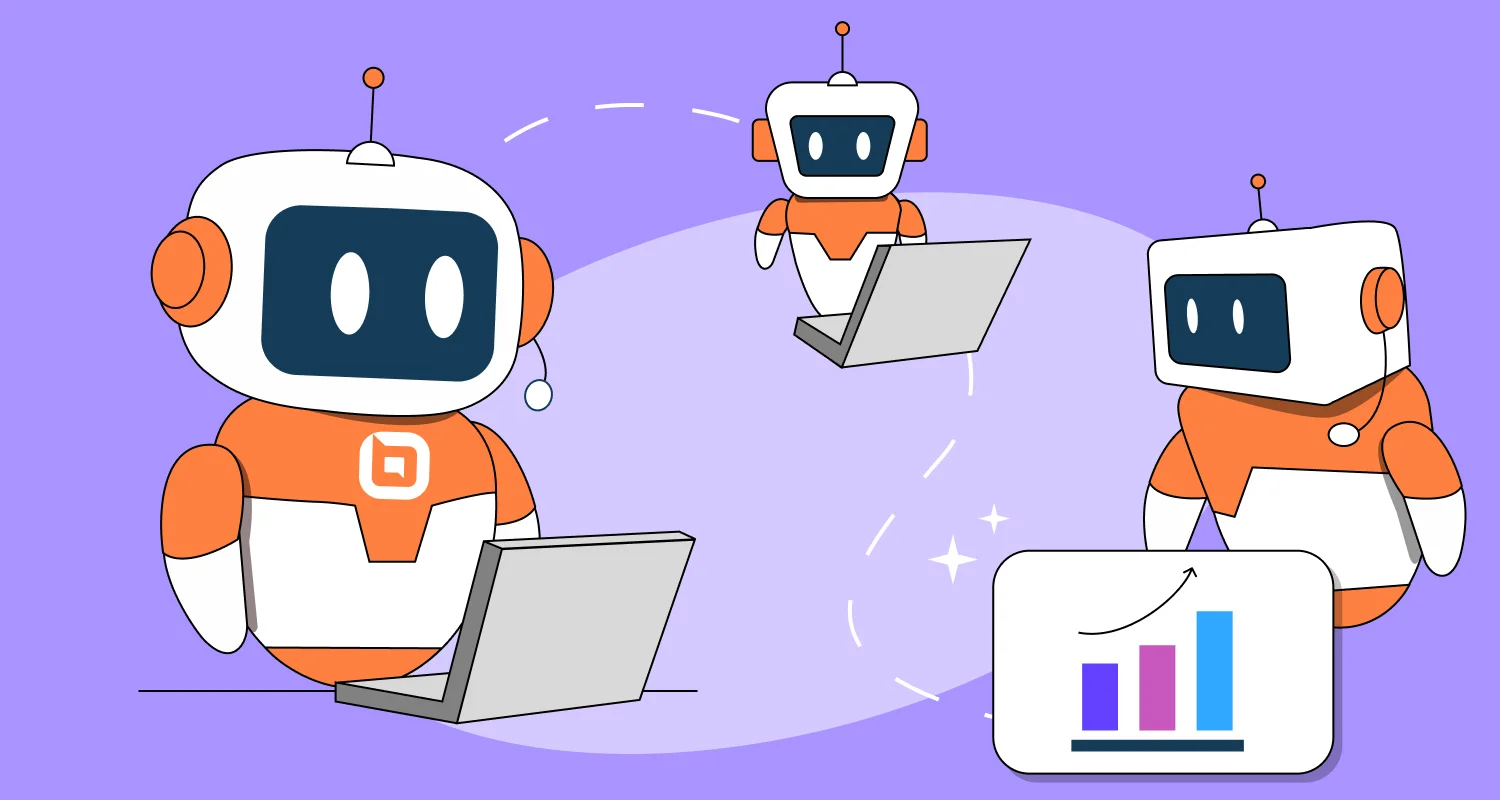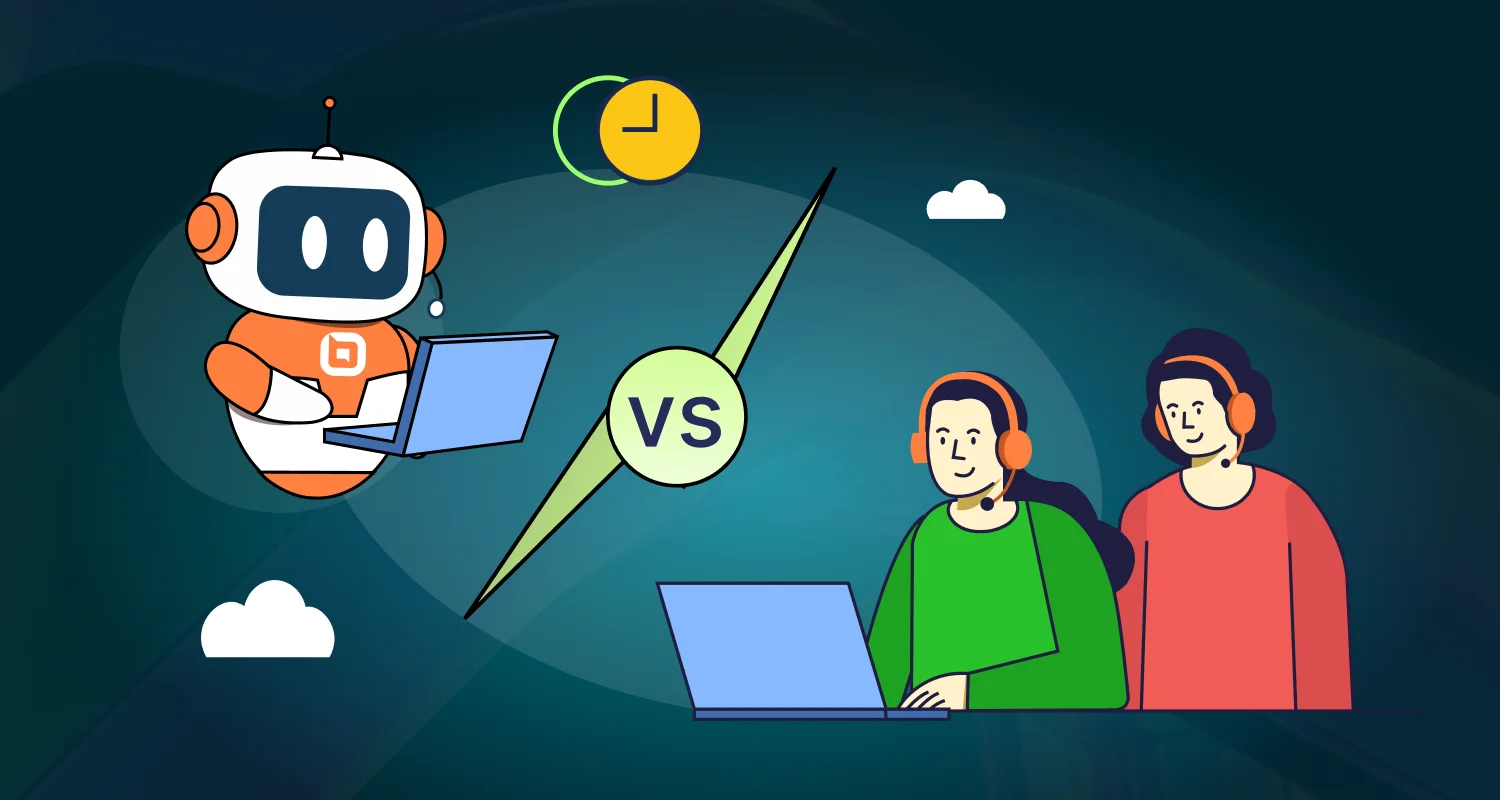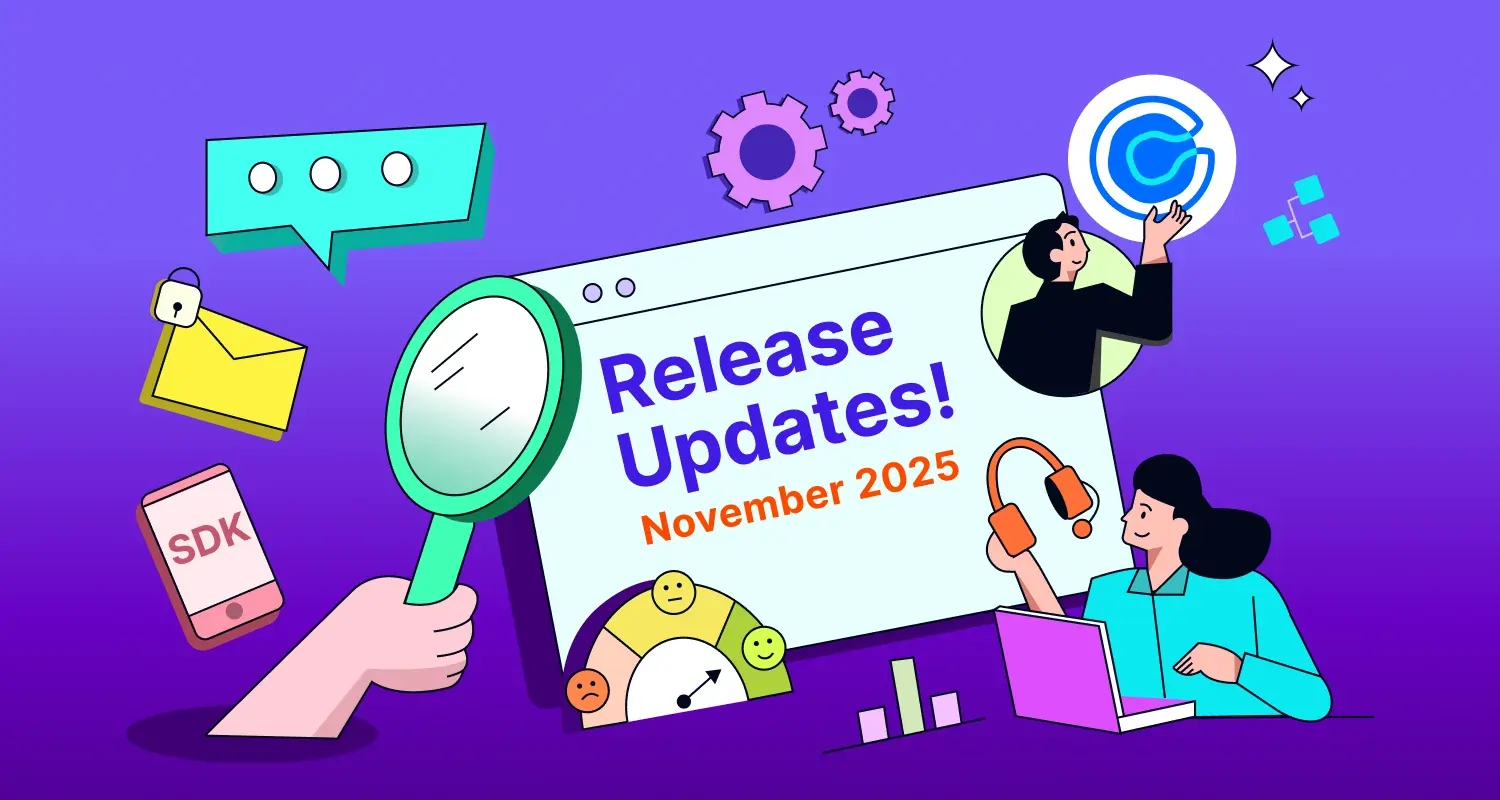Multi-agent AI systems are collaborative groups of specialized AI agents that work together to complete tasks more efficiently than a single agent.
Each agent handles specific responsibilities, such as routing, retrieval, decision-making, or monitoring, while sharing context and coordinating actions in real time.
This distributed architecture improves performance, scalability, accuracy, and resilience, making it ideal for customer service, e-commerce, healthcare, finance, and other high-volume workflows where automation and precision are critical.
In this blog, we’ll dive into how these collaborative AI agents are reshaping work, why they matter, and what it means for the future of customer service and beyond.
What are multi-agent AI systems?
A multi-agent system (MAS) is a group of intelligent AI agents that work together to achieve a common goal.
Each agent has a specific role and can make decisions, share information, and coordinate with others to complete tasks more efficiently.
For instance, one agent answers refund policy questions, another handles shipping delays, and a third checks customer history.
This coordinated division of labor enables each agent to focus on its specific task, collaborate smoothly to resolve customer complaints more accurately, and without needing human help.
What is the difference between single-agent and multi-agent systems?
AI systems can be built in different ways to manage tasks and interactions, most commonly as single‑agent or multi‑agent systems.
A single-agent system uses one autonomous agent to handle tasks independently, making it ideal for simple queries like FAQs.
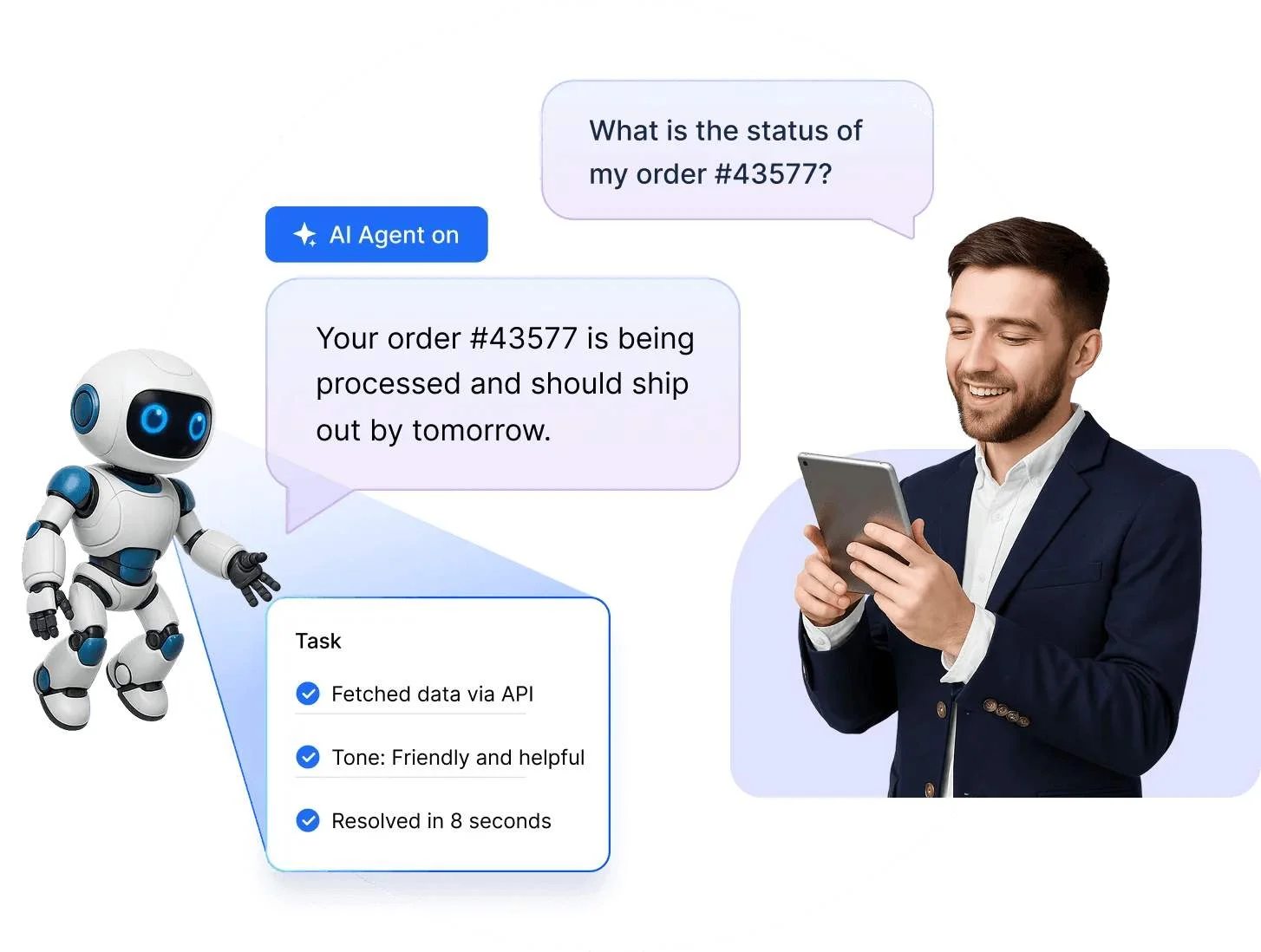
In contrast, a multi-agent system (MAS) involves multiple AI agents collaborating to solve complex problems through communication, coordination, and distributed decision-making.
Here’s a breakdown of how these two systems differ:
| Aspect | Single-agent system | Multi-agent system |
| System design | One agent handles all tasks | Multiple agents work together |
| Interaction | No communication or coordination needed | Agents exchange information and coordinate for teamwork and task sharing |
| Scalability | Limited | Easily scalable with more agents |
| Robustness | The system fails if the agent fails | The system continues even if one agent fails |
| Adaptability | Less flexible | Highly adaptable to changing environments |
Common characteristics of a multi-agent system in AI
Collaborative multi-agent AI systems exhibit distinct traits that enable intelligent teamwork and distributed problem-solving.
These key components define how agents interact, specialize, and coordinate to achieve shared objectives efficiently.

- Collaboration: Multi-agent systems achieve teamwork by dividing complex tasks into sub-tasks based on each agent’s specialization. Agents coordinate by working simultaneously, sharing progress, and synchronizing actions to reach the overall goal efficiently.
- Inter-agent communication: Collaborative AI agents use the Agent2Agent protocol for structured, intent-driven messaging in a shared environment. This protocol standardizes the exchange of goals, status updates, and task requests, enabling seamless coordination and negotiation across the system.
- Autonomy: Each agent operates independently, making decisions based on its capabilities, local data, and assigned subtasks. This self-directed execution delivers speed, scalability, and precision while keeping results aligned with the system’s overall objective.
- Adaptability: Collaborative multi-agent AI systems handle complex, dynamic tasks by adjusting strategies to changing environments, user behavior, or system conditions. When faced with unexpected inputs, shifting goals, or partial failures, agents reconfigure roles, update plans, and sustain high performance.
- Contextual intelligence and memory: Multi AI agents share context and memory to stay aligned, avoid redundancy, and maintain continuity across tasks. This shared awareness extends beyond individual actions, allowing agents to understand and contribute meaningfully to the system’s overall goal.
How do multi-agent systems work?
Multi‑agent AI systems work through teamwork. Rather than one model doing it all, they combine specialized autonomous agents, each with unique strengths, to handle complex tasks efficiently.
By collaborating, these agents turn user requests into clear actions and deliver accurate, scalable results.
Here’s how collaborative AI agents typically operate:
- Understand user request: The system interprets the user’s input to identify goals, context, and requirements.
- Distribute tasks intelligently: Agents compete or negotiate for tasks based on their expertise, ensuring the right agent handles the right subtask.
- Execute role-specific actions: Each agent performs its assigned function, whether analyzing data, validating results, or interacting with external tools, with precision.
- Communicate dynamically: Agents exchange information in real time, aligning outputs and resolving conflicts to maintain consistency.
- Reason and decide in parallel: Using a blend of rule-based logic, machine learning, and environmental awareness, agents make autonomous decisions aligned with their objectives.
- Learn and adapt continuously: Through feedback loops and experience, agents refine their behavior, improving accuracy and efficiency over time.
Benefits of collaborative AI agents
Collaborative AI agents offer a range of operational advantages by working together to solve tasks more efficiently than isolated systems.
Gartner projects that by 2027, 50% of business decisions will be augmented or automated through AI-driven decision intelligence.
The following are some of the advantages that come with using multi-agent AI systems.
- Scalability: Multi-agent systems expand effortlessly by adding more agents as demand grows. This enables them to handle increasing task complexity and large volumes of subsequent operations while maintaining speed, reliability, and overall performance.
- Improved expertise and performance: Each AI agent focuses on a specific task, like tech support or payment issues, meaning they work with precision and speed. This leads to fewer mistakes, quicker answers, and smoother customer support operations.
- Efficient task division: With multiple agents working together, the system can recover from errors efficiently: if one agent fails, another steps in to keep things running smoothly. It’s teamwork that keeps service reliable, even when something goes wrong behind the scenes.
- Real-time responsiveness: Multi-agent systems are capable of reacting to changes or events as they occur. Their ability to process information and make decisions in real time ensures timely responses, which is critical in dynamic environments.
Use cases of collaborative multi-agent AI systems
In this section, we demonstrate how collaborative intelligence can solve domain-specific challenges through coordinated agent behavior.
Each agent contributes its expertise while maintaining shared context, enabling efficient, scalable, and adaptive task execution across industries as follows.
Customer service: Instant, intelligent support
Ever interacted with support and got help instantly? That’s thanks to a team of collaborative AI agents working together.
In customer service, one AI agent figures out what you need, another pulls up the right answers using MCP, while others track your mood and escalate complex issues.
They stay in sync using structured dialogue and event-driven workflows, making customer service feel fast, accurate, and surprisingly personal.
E-Commerce: Seamless shopping experiences
When you shop online, a team of AI agents quietly jumps into action, streamlining actions such as finding the right product, managing returns, among others.
These agents talk to each other through catalog APIs, user behavior models, and logistics systems to keep things running smoothly behind the scenes.
Their teamwork ensures your shopping experience feels fast and hassle-free, but powered by smart coordination.
Healthcare: Smarter, streamlined patient care
Behind every healthcare appointment, multi-agent AI systems collaborate by handling hospital operations from triaging symptoms to guiding discharge processes.
They exchange patient data securely using standardized health protocols like HIPAA and act within clinical decision frameworks. Together, they deliver timely and compliant care without overwhelming human staff.
Banking: Secure and efficient financial operations
Inside your bank’s digital brain, multi-agent systems specialize in handling issues like fraud detection, transaction validation, customer onboarding, and more.
Through seamless communication and coordination, the multi-ai agents exchange structured financial data using secure APIs and rule-based engines to maintain accuracy and boost customer trust. This multi-agent collaboration streamlines operations while safeguarding sensitive assets.
McKinsey found that multi-agent systems boost credit analyst productivity by 20–60%, depending on process maturity.
They also cut decision times by 30%, enabling faster loan approvals and more responsive service, without compromising risk controls.
What are the challenges of collaborative AI agents?
Understanding these challenges is essential for designing resilient, efficient, and trustworthy systems.
Below are key limitations that can impact performance, scalability, and governance.
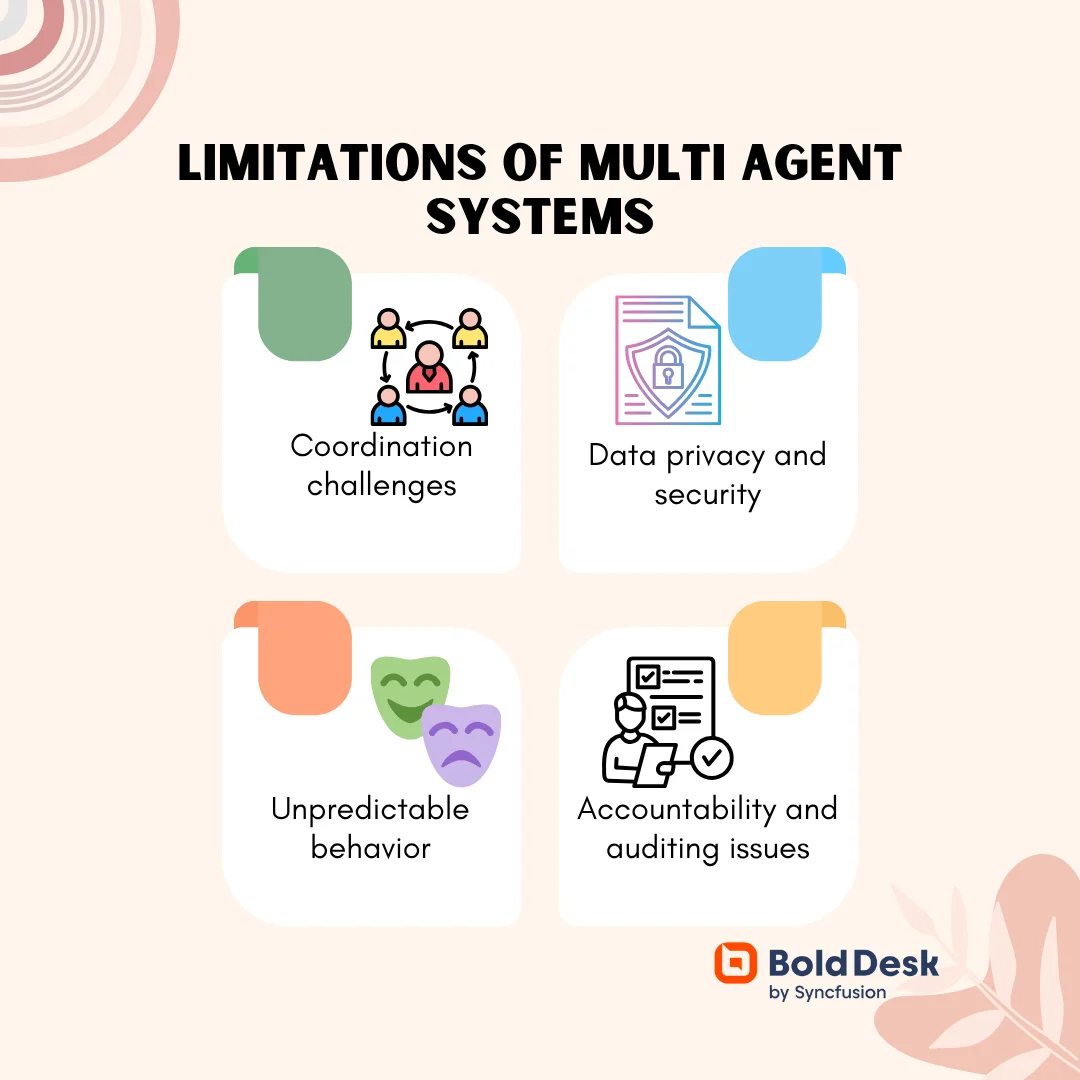
- Coordination challenges: Agents require intricate communication and shared context to collaborate effectively; poor coordination leads to task duplication, conflicts, and scalability issues.
- Data privacy and security: Protecting sensitive data across distributed agents demands robust encryption, access controls, and auditing, which are technically challenging and resource-intensive.
- Unpredictable behavior: Agents may interact in unforeseen ways, producing outcomes that deviate from user goals, requiring continuous monitoring and control mechanisms.
- Accountability and auditing issues: When decisions are made collectively, it becomes difficult to trace responsibility, complicating transparency, legal compliance, and trust in the system.
Enhance your digital workforce with collaborative multi-agent systems
Multi-agent AI systems are redefining intelligent customer support, combining precision, scalability, and adaptive collaboration to resolve complex inquiries faster and more accurately than ever before.
BoldDesk brings the true power of multi-agent AI systems into your help desk operations, empowering teams to automate smarter, act faster, and deliver exceptional experiences.
Ready to transform your support operations with multi-agent intelligence? Experience BoldDesk and see the difference.
For more information, please contact our support team for expert guidance, and also, let us know what you think in the comments section.
Related articles
- Slash Response Times by 30 Minutes Using an AI Ticketing System
- Future of Customer Service: Top Trends for Businesses in 2025
- 10 Best Chatbase Alternatives You Should Consider
Frequently Asked Questions
They can be cooperative, competitive, hierarchical, reactive, deliberative, or hybrid depending on how agents interact, make decisions, and respond to their environment.
Multi-agent system architectures define how agents are organized and interact. The two primary types are:
- Centralized architecture: A supervisor agent (or router) manages task delegation and coordination. It’s efficient for small-scale systems but can become restrictive if overloaded.
- Decentralized architecture: Agents operate independently, sharing information and making decisions locally. This model is more scalable and fault-tolerant, ideal for large or dynamic environments.
Yes. Platforms like BoldDesk enable businesses to create and use multiple AI agents that collaborate to manage tasks efficiently, such as categorizing tickets, automating responses, and improving workflows through shared context and continuous learning.
Agents communicate through structured protocols, APIs, and event-driven workflows, ensuring coordination and shared context for accurate decision-making.
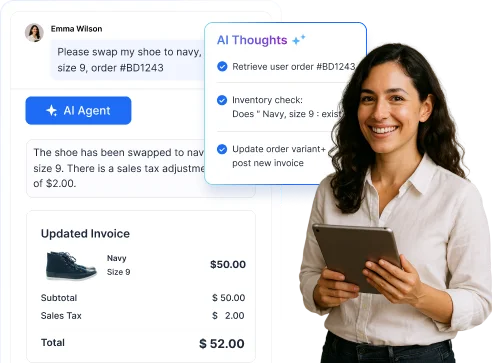


















 Email Ticketing System
Email Ticketing System Shared Inbox Software
Shared Inbox Software Multi Brand Help Desk
Multi Brand Help Desk Internal Help Desk Software
Internal Help Desk Software Trouble Ticketing Software
Trouble Ticketing Software Mobile Help Desk
Mobile Help Desk 









